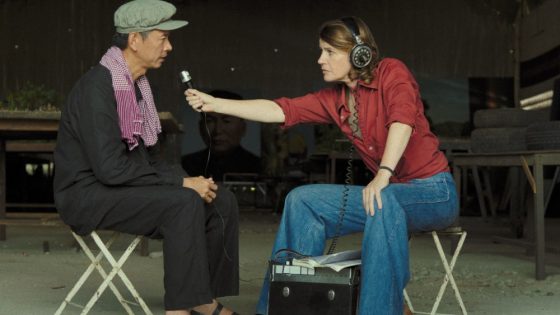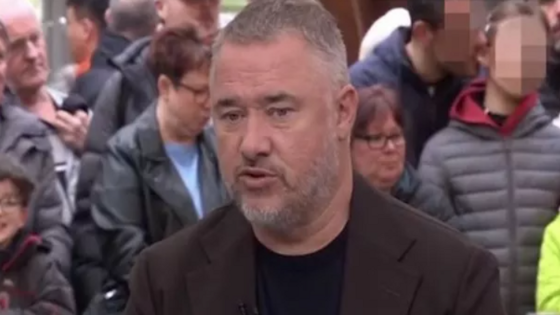A chilling historical drama rendered with impeccable sleight of hand, Rithy Panh’s “Rendez-vous avec Pol Pot” (“Meeting With Pol Pot“) reveals its political dimensions through layers of obfuscation. While based partially on real events (and on the writings of American war journalist Elizabeth Becker), it crafts a fictitious tale of three French journalists attempting to interview Cambodian dictator Pol Pot in 1978. Although its outcomes echo the real experiences of Becker, Scottish academic Malcolm Caldwell, and American reporter Richard Dudman, the film is as much about a specific moment in time as it is about the mechanics of propaganda, which it refutes and embodies in equal measure.
A narrow 4:3 frame introduces the movie’s analogues for Becker, Caldwell, and Dudman, who make their approach by air in the hopes of exposing the opaque Cambodian regime. Irene Jacob plays Lisa Delbo; like Becker — whose work influenced Panh’s 1996 documentary “Bophana: A Cambodian Tragedy” — she’s the only woman on their highly controlled excursion. Her audio interviews are conducted from a place of keen understanding of Communist thought, and of probing curiosity as to Pot’s contortion of it. Grégoire Colin, meanwhile, plays Alain Cariou, a Caldwell stand-in in several ways — those with a working knowledge of the Khmer Rouge will undoubtedly recognize his story — but a character whose objectives are plucked out of Panh’s imagination. Cariou, unlike his French cohorts, is intimately familiar with Cambodia. He was college classmates with the group’s calculating host and interpreter (Bunhok Lim), and he even continues a written correspondence with Pot himself. He also treats his armed handlers with a sense of sycophantic reverence, though whether this is genuine or a survival tactic (or some combination of the two) remains a looming question, as the film explores the ways in which proximity to power can shield people, as well the ways it can’t.
The group is rounded out by Cyril Guei as Paul Thomas, a Black photographer whose only resemblance to the white Dudman is a background detail about the latter’s time covering Vietnam, which Panh yanks into the foreground at a vital third-act development that treats history like a fluid folk tale. But until that time, Thomas embodies a no-nonsense journalistic furor — if an occasionally tactless one, given the risks — over the state’s control over information, and over their visit. What they report on depends on what they’re allowed to photograph and film, but breaking these unwritten rules could also have unintentional consequences for their interview subjects, a dilemma that imbues the story with a pulsating paranoia.
The trio’s perspectives clash in subtle ways as they’re ushered along their tour, but the film makes the case for journalistic solidarity by building creeping dread. It’s a work that feels dangerous in its conception of disinformation, thanks to its shockingly frank depictions of emotional disconnect and compartmentalization. The fragments of reality espoused and enforced by Pot’s officials are occasionally pierced by cracks in the façade, into which the French trio is able to occasionally glimpse.
This fraught dynamic between truth and untruth is also embodied by Panh’s aesthetic approach. The director relies on faded archival film and photographs, presented or superimposed during key moments of fictitious dramatization. These usually appear when Delbo or Thomas pull out their cameras in secret, allowing us to peer into the real history of the Cambodian genocide, and turning the movie’s textured fictional reality inside out. But there are only so many places cameras are allowed to go, so Panh supplements his frame, and the trio’s documentations, with a visual device that seems charming and whimsical, but soon takes on a devious quality.
When the journalists are introduced to the government’s plans for a historical facelift (including replacing certain religious sites with statues of Pot), they’re shown these propositions in the form of carved miniatures — little toys which come to represent ideas in the absence of something tangible. Before long, Panh begins depicting the group’s most controlled visits using these miniatures too, a flourish that becomes increasingly disconcerting as it comes to personify a loss of innocence. In the process, Panh weaponizes the idea of an obfuscating, representational façade, and in the process, makes it entirely revealing of horrors and the way they’re concealed.
All the while, the air remains thick with humidity and warmth, a visual palette that induces a sense of discomfort for the audience and the characters alike. Aymerick Pilarski’s cinematography often recalls that of Vittorio Storaro on Francis Ford Coppola’s partially Cambodia-set “Apocalypse Now”; it not only recalls Storaro’s enrapturing use of light and shadow, but the languid, spine-chilling conversations in the “Redux” cut of Coppola’s war classic, which hold unflinchingly on the cognitive dissonance necessary to commit great acts of horror.
Panh’s lengthy close ups are just as alluring and unsettling, and in turn, the music and sound design enhance his empty landscapes with eerie hums. It’s as though something were deeply amiss in in the fabric of reality. The result is a hauntingly timeless depiction of power and its mechanisms, filtered down to an intimate tale of journalistic integrity.
Source Agencies



